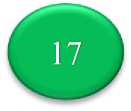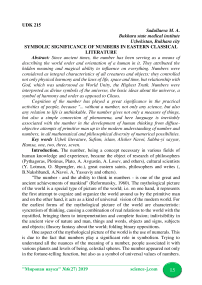Symbolic significance of numbers in eastern classical literature
Автор: Sadullaeva M.A.
Журнал: Мировая наука @science-j
Рубрика: Основной раздел
Статья в выпуске: 6 (27), 2019 года.
Бесплатный доступ
Since ancient times, the number has been serving as a means of describing the world order and orientation of a human in it. They attributed the hidden meaning and magical ability to influence on everything. Numbers were considered as integral characteristics of all creatures and objects: they controlled not only physical harmony and the laws of life, space and time, but relationship with God, which was understood as World Unity, the Highest Truth. Numbers were interpreted as divine symbols of the universe, the basic ideas about the universe, a symbol of harmony and order as opposed to Chaos. Cognition of the number has played a great significance in the practical activities of people, because "... without a number, not only any science, but also any relation to life is unthinkable. The number gives not only a measure of things, but also a simple connection of phenomena, and here language is inevitably associated with the number in the development of human thinking from diffuse-objective attempts of primitive man up to the modern understanding of number and numbers, in all mathematical and philosophical diversity of numerical possibilities.
Uzbek literature, sufism, islam, alisher navoi, sabba-yi sayyar, hamsa, one, two, three, seven
Короткий адрес: https://sciup.org/140264721
IDR: 140264721 | УДК: 215
Текст научной статьи Symbolic significance of numbers in eastern classical literature
Introduction. The number, being a concept necessary in various fields of human knowledge and experience, became the object of research of philosophers (Pythagoras, Plotinus, Plato, A. Avgustin, A. Losev, and others), cultural scientists (Y. Lotman, O. Shpengler, etc.), great eastern saints, philosophers and writes (, B.Nakshbandi, A.Navoi. A, Yassaviy and others).
"The number - and the ability to think in numbers - is one of the great and ancient achievements of mankind" (Reformatsky, 1960). The mythological picture of the world is a special type of picture of the world; i.e. on one hand, it represents the first attempt to cognize and organize the world around us by the primitive man and on the other hand, it acts as a kind of universal vision of the modern world. For the earliest forms of the mythological picture of the world are characteristic: syncretism of thinking, causing a combination of real relations to the world with the mystified, bringing them to interpenetration and complete fusion; indivisibility in the ancient view of nature and man, things and words, objects and signs, subjects and objects; illusory fantasy about the world; folding binary oppositions.
One aspect of the mythological picture of the world is the use of numerals. This is due to the fact that numbers play a significant role in symbolism. Trying to understand all the nuances of the meaning of a number, people associated it with various planets and levels of being, celestial spheres. The number appeared not only in the fortune-telling function, but also as a symbol of universal values of numbers.
People believed in the magical significance of numbers, in their classifying, organizing, purposeful role in nature and society. In their imagination, numbers were not only equivalents of the magnitude of the singularity or multiplicity of objects of the surrounding reality, but reflected, first of all, the inner, deep essence of the elements of the universe in its connections and integrity. Therefore, they expressed not only quantitative, but also qualitative indicators of all that is inherent in nature, society and consciousness[1].
Numbers can be interpreted from different points of view. First, different ideas are associated with individual numbers or even with arithmetic operations in specific cultures. Secondly, many scholars, philosophers, poets believe that the number stands behind the word, sound and other signs, i.e. the number tis the basis of poetry, art, and worldview in general. The number conveys all the shades of meaning and rules the world. In oral and written literature of the world there are many concepts related to numbers, which are used by masters of words for artistic purposes. Concepts based on numbers may be of real scientific, philosophical, mythological or religious origin.
If we start directly with number “one”, in very ancient times the visible world had emerged from this number, and this number reflects the spirit and is thought to be the symbol of wisdom, kindness, unity and happiness. This number is used in the context of religion and Sufism as the absolute presence of the world. In particular, in the samples of sufist literature, we often see that "one" is often used to recognize the Creator's uniqueness. For example, in Ahmed Yassaviy's wisdom, he addressed to Allah: "My Only one, will i ever witness Your countenance?"
The views of ancient Greek scholars on number "two" are closer to the views of Eastern philosophers. Indeed, the Greeks also pointed out "two" as the sign of contradictions, conflicts, dissatisfactions, and dissenting. Majnun(lover) of Allah will leave dualism thought, i.e. he abandons himself from "me" and "you". A. Navoi says, who reaches perfect uniqueness sees “The Only One”, hears “The Only One”, speaks about “The Only One”:
Bir bilu bir kiru bir de, bir to`la,
Mayl qilma munda ikkilik bila.
Ikkilik bu yo`lda ashvolliqdurur,
Sirri vahdatdin mu`attalliq durur.[2]
The ideas of the world and the Heraafter are expressed mainly by the terms "two worlds" and "two universes " and they are often of a typical nature. In the poem of Alisher Navoi "two" is used together with the words like "world", "universe", "globe", "nature" and expresses evanescent and eternal world. The poet used term "two worlds" more than 60 times in his "Khazoyinul maoniy" and "Hamsa" . The true lovers refused two worlds' gifts to achieve God's countenance:
Arz etsalarki, yor kerak yo iki jahon,
Yor aytqumdurur beri, ikki jahon nari.
Ikki jahonni ko`rar vasl mone`i solik,
Murod yor esa, ham mundinu, ham andin kech. [3]

According to Islamic teachings, there are a number of angels and each of them has an important task. For example, there are views of Munkar and Nakir, the angels of benignity, who come to know about the deeds of a human in the world after death. The following are the words of these angels in the book of "Etiqodiya" by Bobur dedicated to his sons Humoyun and Komron Mirzo:
Ikkisi gir ichidadur soyo`l,
Shaklu shay`atlari base shoyo`l:
Biri Munkir, biri Nakir durur.
Bori shukm ilgida asir durur.[4]
According to Islamic views, after the body is placed in the grave and when seven steps are done, these two angels come to question the corpse.
It was known that Khalif Usman married to the two daughters of Muhammad (peace be upon him), so 'Usman ibn' Affan was given the name of the "Zunnur ayn", the master of two lights. Alisher Navoi's “Lison Ut-Tayr:”contains the following:
Ul hayo koniki nurul-ayn edi,
Iylakim aynayn zun-nurayn edi…
Kimga bergay dastkim rabbi g`afur,
Kulbasig`a solg`ay andoq ikki nur. [5]
Though number “three” was widely used in Uzbek oral literature, there are not much recordings concerning this number in Uzbek classic literature or religious writings. A.Navoi referred to this number in his “Saddi Iskandariy”:
Chu obog`a bu nav’berding sifot,
Alar taxtida aylading ummahot.
Ato yetti-yu, to`rt qilding ano
Natija uch etting bulardin yano
Here author refers to 3,4,7. Seven symbolizes seven layers of heaven and stands for father in the poem, four- four seasons stands for mother and three- are the zodiac signs in accordance with 4 seasons. [6]
Abu Nasr Al-Farabi(873-950) in his book “The Purpose of Recitation” has said that Allah has given human beings three power to his lust and declared that these powers are in three aspects: power of thoughts (quvvai fikriya), power of temptation(quvvai shahvoniya), power of anger( quvvai g`azabiya). Each of these powers has three different moods: 1.Beyond normal (istilo) ; 2. Average (e'tidol) 3. Defect (nuqson).[7]
Eastern medicine has three types of sleep habits. 1. Laylula - night sleep (most common). 2. Qaylula - after noon sleep. 3. Faylula - short-term sleep after morning pray.
The three principles of Bahauddin defined the zikr (remembrance) of brotherhood as “silent” zikr. The first principle is “awareness of time” (vukuf - and zamani), that is, constant self-observation and introspection during the zikr. The second principle is “awareness of the number” (vakuf - and adadi), that is, counting the number of zikr formulas in order to avoid the appearance of distracting thoughts. The third principle is “awareness of the heart” (wokuf - and kalbi), that is, focusing

on the physical heart. "Quiet" zikr badly fit with the music and dance during the celebrations (itself). Hence the negative attitude towards them. [8]
According to the doctrine of Nakshbandiya, there are following degrees of human lust:
-
1. Nafsi ammora (bad)
-
2. Nafsi lavvoma (bad but not free of conscience)
-
3. Nafsi mutma'inna (calm)
-
4. Nafsi mulhama (inspirational, noble)
-
5. Nafsi marzia (agree)
-
6. Nafsi Sofiya (free of ambitions),
-
7. Nafsi komila (perfect).
Knowing the levels of temptation, will serve to examine and purify the inner self of a person, leave behind the defects in his desires[9].
The number “seven” was of particular importance in mitraculture (sun worship), according to which there are seven stages of lighting a sun-worshiper, which begins with a special ablution and is accompanied by ritual exercises.
The number "seven" is also emphasized in Christianity. When St. Johann was illuminated, he had seven souls, seven suns, seven pictures, a dead lamb with seven horns and seven eyes, seven golden bowls, seven countries, seven angels who were present with God and who were given seven trumpets.
According to ancient Indian mythological concepts, Beruni (973- 1048, great Eastern philosopher and scientist) witnesses that there are seven lands lying one on another and seven heavens located one after another, which are correlated with the parts of the body - the earth with parts from the navel to the foot, and heaven from the skull to the stomach. Beruni notes that, on the basis of religious legends, Indians adhere to such notions: The land on which we are located is round and surrounded by the sea. Behind this sea is a land in the shape of a necklace, and beyond that land there is still a round sea. This row continues until the number of seas and necklaces from dry lands, called islands, ends with seven.
The number of "seven" mainly under the influence of other religions has acquired a certain value in Islam. It is repeatedly mentioned in the Quran. The coverage of the number “seven” reached its perfection among the Shiite seven-rosterns, whо recognize only seven imams and not twelve as others. The seven-rosterns (sab’iyya) associate all cosmological concepts and world events with the number “seven.” They believe that the emergence and development of existence has seven stages: the first stage is the existence of God, the second is the creation of the universal soul, the fourth is the creation of primary substance, the fifth is the emergence of space, the sixth is the occurrence of time and the seventh is the emergence of earthly life.
In the Islamic literature the number "seven" is quite common. In one of the anonymous Ismaili treatises of religious and philosophical content, it is stated that there are seven climatic zones in the sky, seven parts in the human body. Hurufits,

who deified a man, saw on his face seven black features, considered maternal and seven white - paternal. The main divine features were maternal.
The number "seven" is of great importance in Sufi literature. In Sufism, there has been created many seventh related to the seven heavens or galaxies. For example, it is mentioned seven qualities of human being comparably to seven heavens: life, knowledge, hearing, sight, power, speech and will. The following concepts are associated with this number:
-
- Seven states (atvar-and sabʻa), the first one is the natural state (Taʻb), the second is passion (nafs), the third is heart (k, alb), the fourth is spiritual (ruh), the fifth is secret (sirr) the sixth is hidden (hafi), the seventh is the most hidden (ahfa).
-
- Seven Valleys (Haft Wadi). The first valley is a pretense (talab), the second is love (ishk), the third is cognition (marifat), the fourth is independence (istahna), the fifth is unity (tawhid), the sixth is confusion (khairat) and the seventh is selfforgetfulness (fan) .
-
- Seven husbands (Haft Mardan) seven groups of enlightened men: Aktab (leaders, literally “poles”), Abdal (saints), Aykhar (benefactors), Avtad (pillars), Gavs (patron), Nuqaba (leaders), Nudjaba (noble) .
A mature artist can use the concepts of any origin as a definition of the elements of the form in his work with real content. Among such artists in the field of verbal art is Alisher Navoi, who skillfully used the symbolism of numbers in the poem “Saba-yi sayyar”. As it is known, A. Navoi adhered to the teachings of Sufism, which was reflected in his work “Sabai Sayor”. Navoi pays special attention to symbolism. Let’s consider this in the following passage:
Lutf bu nazm aro bagʼoyatdur
Garaz ammo yetti (seven)hikoyatdur
Chunki qoyil yetti(seven) musofir edi,
Ki alar sayr shunga mohir edi.
Boʼldi chun bu raqam ishi tayyor,
Qoʼydim otini “Sabʼai sayyor”
This poetic passage confirms that Navoi attaches great importance to symbols. He emphasizes that his purpose is to tell the seven stories of seven wanderers. He associates the number seven with the names of celestial bodies in Eastern astronomy and color symbols. The stories are set forth by seven wanderers from seven continents for seven days in palaces of seven colors. Seven palaces correspond to the seven planets. Seven planets illuminate the seven continents of the earth.
Chekting etkanda zaxr bunyodni
Yetti gumbaz sipoxri minozin
Sun'ung etti bu yetti koki rafi'
Natm gavxarlari bila tarsi'
Yetti koh ichra yetti farzona
Degali hikmatingdan afsona,
Yetti afsona barchasi zinband
Ikkisi bir-biriga yuk monand

Yetti gumbaz agarchi minorang
Yetti afsona lek rango-rang
Sen chekib murtafi' yetti aflok,
Mulkat aylab bu ichra markazi xok
Yetti gardun demayki yetti lagan
Har biri ichra shamь nur afgan
Har lagan durmi kavkab afruzi,
Kavkabi gavhari shab afruzi
Har birisida uzra xosiyat
O`zgacha rashku o'zga mohiyat,
Аzr jirmi qilib eti tahsim
Аylading har birini bir iqlim
Ul eti kavkati jahon paymo
Ne jahon, balki osmon paymo
Kim yetti ko'kda keldilar soyir,
Suvda andokki netgun toyir
Har biri solibon qo'ilurda zuhur
Yetti iqlimdan biri uzra nur
Raxmatingdin ziyo tutub har sham
Sham yo`q yetti luʼbati raqqos
Haftaning kuni birisiga mos.
In this passage, the number seven is often used. In particular, Navoi, turning to the Almighty Allah, says: “You created the sky. It consists of seven layers. They are like seven domes. ” The poets of the East subtly felt the magical purpose of the numbers. Seven celestial domes in our opinion means seven layers of the atmosphere. According to Navoi, God created seven heavenly castles. In these castles, the seven wise men read his wise words. These legends are alike at all. Despite the fact that these domes are turquoise in color, the seven legends are decorated with different colors. Then Navoi writes: “You exalted, oh, Allah, these seven heavens high and lowered their center. These seven heavens are like the seven saucers. Inside each there are radiant candles. In every saucer there are stars like emeralds. Oh, Allah You divided the Earth into seven parts and each part can be compared to one continent. Seven planets are wandering through the world, through the sky. As they appear, these seven continents are becoming bright. They take energy from you and light up the night. No, they are not candles, but magnificently beautiful dancers. They are connected with one day of the week and the day like flower buds, and at night they are moon-faced beauty.
As known, a follower of Sufism while approaching Almighty Allah, must go through seven steps of Sufi teachings. When he reaches full perfection he does not feel the needs for the seven things necessary for human life: air, food, water, movement and rest, sleep, digestion and metabolism. In other words, he merges with the Almighty. As we see, the number 7 is also important here. In addition to cosmogony concepts, this number denotes vital concepts.

Conclusion. Thus, the following conclusions can be drawn from the abovementioned thoughts and interpretations:
-
- From the earliest times of the history of literature, our classic poets have used numerical figures in expressing certain truths and ideas. It was certainly carried out by symbolic-figurative interpretation of one or another number, and this concept gradually became a kind of Ideological artistic tradition. The number that gives us a definite meaning is gradually increasing to the symbolic-figurative "image" that reflects divine-philosophical essence. As an example, we can consider number "one".
-
- The fact that the numbers are widely used in Uzbek literature is directly related to Sufism education. It is not a mistake to say that Sufi teaching and literature have a unique semantic system of numbers. This is because several new routes have been opened for each number. This is totally different from the numbers used in folk art, mythology, superstitions and traditions. It is natural, therefore, to study Sufism and divine truths to be able to understand the true essence of the material containing numbers in the texts of classic and Sufi literature.
-
- Using the numbers in art literature and the main purpose of expressing ideas using numbers is to reveal the secret of the universe through human beings, universe truths through the features and qualities of a perfect human being. When it came to the works of Alisher Navoi, number one, two,seven, nine columns and eighteen thousand universes, were intended to illuminate the essence of the perfect man.
Список литературы Symbolic significance of numbers in eastern classical literature
- Ирисқулова Н. Ш. Национально-культурная специфика и символическая значимость числительных. Диссертация.Т.,2015
- A.Navoiy.MAT.XII jild.-Toshent,1996.
- A.Navoiy.MAT.XII jild.-Toshent,1996.
- Karomatov Sh. Qur'on va o'zbek adabiyoti. - Toshkent: Fan, 1993.
- Ochilov E. Navoiy g'azallarida komil inson timsoli // O'zbek tili va adabiyoti. - 2001. - 1-son
- A.R.Beruniy. tanlangan asarlar. V jild, 1-kitob, Toshkent. 1973, 87-B
- Умр ва нафс. Янги аср авлоди. Т.: 2002. 32 б. (Нашрга тайёрловчи- филология фанлари номзоди И. Остонақулов.
- https://vidya613.wordpress.com
- Нақшбандия тариқатига оид қўлёзмалар фихристи. "Мовароуннаҳр" нашриёти. Тошкент. 1993


